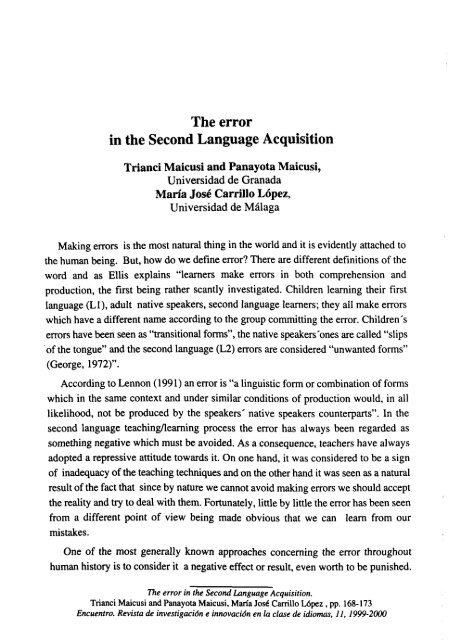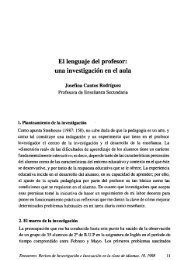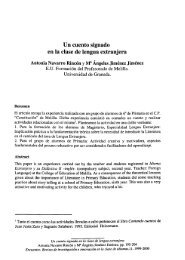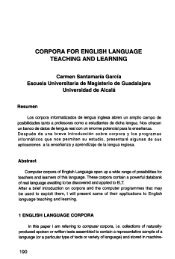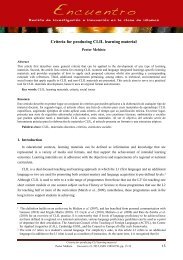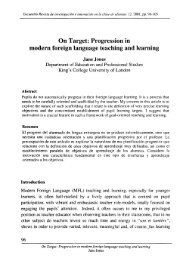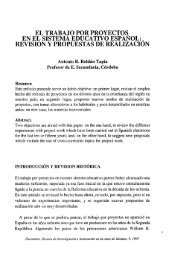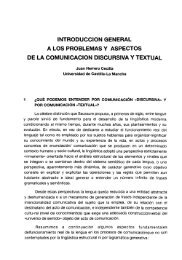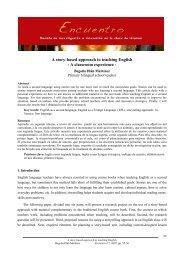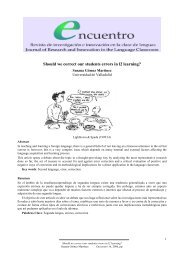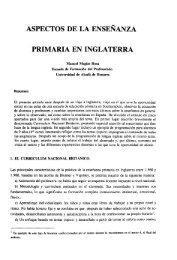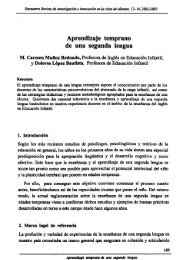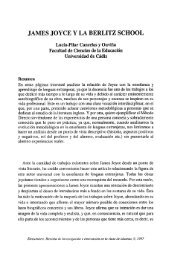The Error in the Second Language Acquisition
The Error in the Second Language Acquisition
The Error in the Second Language Acquisition
You also want an ePaper? Increase the reach of your titles
YUMPU automatically turns print PDFs into web optimized ePapers that Google loves.
<strong>The</strong> error<strong>in</strong> <strong>the</strong> <strong>Second</strong> <strong>Language</strong> <strong>Acquisition</strong>Triancí Maicusi and Panayota Maicusí,Universidad de GranadaMaría José Carrillo López,Universidad de MálagaMak<strong>in</strong>g errors is <strong>the</strong> most natural th<strong>in</strong>g <strong>in</strong> <strong>the</strong> world and it is evidently attached to<strong>the</strong> human be<strong>in</strong>g. But, how do we def<strong>in</strong>e error? <strong>The</strong>re are different def<strong>in</strong>itíons of <strong>the</strong>word and as EUis expla<strong>in</strong>s "leamers make errors <strong>in</strong> both comprehension andproduction, <strong>the</strong> first be<strong>in</strong>g ra<strong>the</strong>r scanüy <strong>in</strong>vestigated. Children leam<strong>in</strong>g <strong>the</strong>ir firstlanguage (Ll), adult native speakers, second language leamers; <strong>the</strong>y all make errorswhich have a different ñame accord<strong>in</strong>g to <strong>the</strong> group committ<strong>in</strong>g <strong>the</strong> error. Children'serrors have been seen as "transitional forms", <strong>the</strong> native speakers'ones are called "slipsof <strong>the</strong> tongue" and <strong>the</strong> second language (L2) errors are considerad "unwanted forms"(George, 1972)".Accord<strong>in</strong>g to Lennon (1991) an error is "a l<strong>in</strong>guistic form or comb<strong>in</strong>ation of formswhich <strong>in</strong> <strong>the</strong> same context and under similar conditions of production would, <strong>in</strong> alllikelihood, not be produced by <strong>the</strong> speakers' native speakers counterparts". In <strong>the</strong>second language teach<strong>in</strong>gAeam<strong>in</strong>g process <strong>the</strong> error has always been regarded assometh<strong>in</strong>g negative which must be avoided. As a consequence, teachers have alwaysadopted a repressive attitude towards it. On one hand, it was considered to be a signof <strong>in</strong>adequacy of <strong>the</strong> teach<strong>in</strong>g techniques and on <strong>the</strong> o<strong>the</strong>r hand it was seen as a naturalresult of <strong>the</strong> fact that s<strong>in</strong>ce by nature we cannot avoid mak<strong>in</strong>g errors we should accept<strong>the</strong> reality and try to deal with <strong>the</strong>m. Fortunately, little by little <strong>the</strong> error has been seenfrom a different po<strong>in</strong>t of view be<strong>in</strong>g made obvious that we can leam from ourmistakes.One of <strong>the</strong> most generally known approaches concem<strong>in</strong>g <strong>the</strong> error throughouthuman history is to consider it a negative effect or result, even worth to be punished.<strong>The</strong> error <strong>in</strong> <strong>the</strong> <strong>Second</strong> <strong>Language</strong> <strong>Acquisition</strong>.Trianci Maicusi and Panayota Maicusi, María José Carrillo López, pp. 168-173Encuentro. Revista de <strong>in</strong>vestigación e <strong>in</strong>novación en la clase de idiomas, 11, 1999-2000
Different societies have regarded error as <strong>in</strong>dicat<strong>in</strong>g failure and obstruct<strong>in</strong>g progress.Punish<strong>in</strong>g <strong>the</strong> error has always occurred along with teach<strong>in</strong>g and leam<strong>in</strong>g processesand has always been used as an <strong>in</strong>strument of power and a teach<strong>in</strong>g strategy. At alltimes has <strong>the</strong> error been systematically persecuted and even <strong>in</strong> our days despite <strong>the</strong>numerous protest<strong>in</strong>g voices. <strong>The</strong> idea of <strong>the</strong> error as an effect to be avoided has beenespecially supported by behaviourism, be<strong>in</strong>g considered an obstacle to languageleam<strong>in</strong>g. <strong>The</strong> behaviourists viewed error as a symptom of <strong>in</strong>effective teach<strong>in</strong>g or asevidence of failure and <strong>the</strong>y believed that when <strong>the</strong>y occur <strong>the</strong>y are to be remedied byprovisión of correct forms; that is to say, use of <strong>in</strong>tensive drill<strong>in</strong>g and over-teach<strong>in</strong>g.Although Behaviourism may be strongly criticised as a conception it has representedconsiderable progress as far as error treatment is coneemed, plac<strong>in</strong>g emphasis on <strong>the</strong>different characteristics of <strong>the</strong> different subjects and elim<strong>in</strong>at<strong>in</strong>g hard punishment.A quite different conception from <strong>the</strong> behaviouristic one is <strong>the</strong> one that affirms thatwithout error <strong>the</strong>re is no progress. What <strong>the</strong> error-as-progress conception is based onis Chomsky's idea that a child generates language through <strong>in</strong>nate universal structures.So, us<strong>in</strong>g this symbolic code one can have access to different pieces of knowledge notas someth<strong>in</strong>g mechanically leamed but as mentally constructed through try and error.<strong>The</strong> idea is now that <strong>the</strong> second language leamers form hypo<strong>the</strong>ses about <strong>the</strong> rules tobe formed <strong>in</strong> <strong>the</strong> target language and <strong>the</strong>n test <strong>the</strong>m out aga<strong>in</strong>st <strong>in</strong>put data and modify<strong>the</strong>m accord<strong>in</strong>gly. This is how <strong>the</strong> error promotes progress and improvement <strong>in</strong>leam<strong>in</strong>g. <strong>The</strong> behaviourists' model is now substituted by <strong>the</strong> mentalists' one andthanks to this new conception <strong>the</strong> error is fínally seen as someth<strong>in</strong>g positive and notas a problem.<strong>The</strong> third approach concem<strong>in</strong>g error is <strong>the</strong> one consider<strong>in</strong>g error to be <strong>the</strong> result of<strong>the</strong> social -cognitive <strong>in</strong>teraction. This means that <strong>the</strong> error implicitly cardes a socialnorm as well as a cognitive process. <strong>The</strong> error or mistake also carnes a social andcultural component which makes it different <strong>in</strong> different societies.An outl<strong>in</strong>e of <strong>the</strong> recent evolution of conceptions, ideas and research on this áreahelps US to conceive how and why language teach<strong>in</strong>g nowadays has come to focus on<strong>the</strong> leamer and <strong>the</strong> leam<strong>in</strong>g process. Accord<strong>in</strong>g to <strong>the</strong> Contrastive Analysis Hypo<strong>the</strong>sis,errors occur as a result of <strong>in</strong>terference when <strong>the</strong> leamers transfer native language habits<strong>in</strong>to <strong>the</strong> L2. It was also believed that <strong>in</strong>terference takes place whenever <strong>the</strong>re is adifference between native mo<strong>the</strong>r tongue and <strong>the</strong> target language. A hypo<strong>the</strong>sis basedon Lado's suggestion <strong>in</strong> l<strong>in</strong>guistic across cultures where he states "<strong>in</strong> <strong>the</strong> comparisonbetween native and foreign language lies <strong>the</strong> key to ease all diffículties <strong>in</strong> foreignlanguage leam<strong>in</strong>g" (Lado, 1957).169
Lado underl<strong>in</strong>ed <strong>the</strong> tight relation between Contrastive analysis and languageteach<strong>in</strong>g; although it constitutes an important contribution to language teach<strong>in</strong>g, to dateContrastive Analysis is just one more among a number of analyses. In fact, it limitsitself to provid<strong>in</strong>g us with didactic <strong>in</strong>formation. <strong>The</strong> most important contribution of thisk<strong>in</strong>d of analysis is <strong>the</strong> delimitation of second language structures which obstructleam<strong>in</strong>g. Based on this <strong>in</strong>formation it is possible to make decisions concem<strong>in</strong>gteach<strong>in</strong>g. In fact, it is <strong>the</strong> knowledge of <strong>the</strong> difficulties result<strong>in</strong>g from <strong>the</strong> differencebetween first language structures and target language ones which permits <strong>the</strong>developement of efficient strategies to face error.<strong>The</strong> error analysis supplanted Contrastive Analysis and became a recognised partof Applied L<strong>in</strong>guistics ow<strong>in</strong>g to <strong>the</strong> work of Corder (1967) who saw it from a differentpo<strong>in</strong>t of view :A leamer's errors <strong>the</strong>n, provide evidence of <strong>the</strong> system of <strong>the</strong> language that he isus<strong>in</strong>g.. .<strong>the</strong>y are significant <strong>in</strong> three different ways. First to <strong>the</strong> teacher, <strong>in</strong> that <strong>the</strong>y tell him,if he undertakes a systematic analysis, how far towards <strong>the</strong> goal <strong>the</strong> leamer hasprogressed.. .<strong>Second</strong>, <strong>the</strong>y provide <strong>the</strong> researchers with evidence of how language is leamedor acquired.. .Thirdly <strong>the</strong>y are <strong>in</strong>dispensable to <strong>the</strong> leamer himself because he can regard <strong>the</strong>mak<strong>in</strong>g of error as a device used <strong>in</strong> order to leam.<strong>The</strong> <strong>Error</strong> Analysis is concemed with <strong>the</strong> same problems as Contrastive Analysisbut from an oppos<strong>in</strong>g po<strong>in</strong>t of view. In <strong>Error</strong> Analysis,<strong>the</strong> error has been def<strong>in</strong>ed asa deviation from <strong>the</strong> norm of <strong>the</strong> target language and a dist<strong>in</strong>ction has been madebetween errors and mistakes. <strong>The</strong> error is what takes place when <strong>the</strong> deviation arisesas a result of lack of knowledge whereas <strong>the</strong> mistake comes up when leamers fail toperform <strong>the</strong>ir competence. <strong>Error</strong>s have been fur<strong>the</strong>r divided <strong>in</strong>to overt and covert(Corder, 1971), errors of correctness and appropriatness, as far as identification of erroris concemed, and <strong>in</strong>to presystematic, systematic and postsystematic regard<strong>in</strong>g <strong>the</strong>irdescription (Corder, 1974).In general, L2 acquisition research tackled with <strong>the</strong> error sources which might bepsychol<strong>in</strong>guistic, sociol<strong>in</strong>guistic, epistemic or resid<strong>in</strong>g <strong>in</strong> <strong>the</strong> discourse structures.Richards (1971), when try<strong>in</strong>g to identify <strong>the</strong> causes of competence errors he came upwith three types of errors: <strong>in</strong>terference errors, which reflect <strong>the</strong> use of elements fromone language to <strong>the</strong> o<strong>the</strong>r, <strong>in</strong>tral<strong>in</strong>gual errors, subdivided <strong>in</strong>to errors due toovergeneralization, or to ignorance of rules restriction, which is <strong>in</strong>completeapplication of <strong>the</strong> rules, or fmally due to <strong>the</strong> false concept hypo<strong>the</strong>sis, whichdemónstrate <strong>the</strong> general characteristics of rule leam<strong>in</strong>g and third developmental errorswhen <strong>the</strong> leamer builds hypo<strong>the</strong>sis about <strong>the</strong> target language based on limitedexperience.170
Ano<strong>the</strong>r división was made by Dulay and Burt <strong>in</strong> 1974 accord<strong>in</strong>g to which <strong>the</strong>re arethree types of error: <strong>the</strong> developmental ones which are based on <strong>the</strong> identity hypo<strong>the</strong>sisare similar to <strong>the</strong> errors made <strong>in</strong> Ll acquisition, <strong>in</strong>terference errors and unique errorswhich cannot fall <strong>in</strong>to ei<strong>the</strong>r of <strong>the</strong> above mentioned categories. <strong>Error</strong> Analysis wascriticised for its weaknesses <strong>in</strong> <strong>the</strong> methodological procedures and its Hmited scope.It has been claimed that <strong>the</strong> <strong>Error</strong> Analysis has not succeeded <strong>in</strong> provid<strong>in</strong>g a completeview of language acquisition describ<strong>in</strong>g it as exclusively a collection of errors.Schachter, Celce-Murcia(1977) criticised <strong>Error</strong> Analysis on <strong>the</strong> grounds of itsfocus<strong>in</strong>g on errors, of <strong>the</strong> fact that researchers are denied access to <strong>the</strong> whole pictureand of fail<strong>in</strong>g to account for all <strong>the</strong> áreas of <strong>the</strong> L2 <strong>in</strong> which leamers have difficulties.Never<strong>the</strong>less, despite <strong>the</strong> constructive criticism <strong>the</strong> <strong>Error</strong> Analysis has been veryimportant <strong>in</strong> <strong>the</strong> sense that it has given <strong>the</strong> error respectability and it has made obviousthat <strong>the</strong> errors are a positive element <strong>in</strong> language leam<strong>in</strong>g.It is well known, that <strong>in</strong> <strong>the</strong> last years <strong>the</strong> approach to language leam<strong>in</strong>g haschanged substantially. Nowadays, language teach<strong>in</strong>g basically focuses on <strong>the</strong>communicative competence.<strong>The</strong> communicative approach is different than <strong>the</strong> previousteach<strong>in</strong>g methods even where error correction is concemed. In Communication<strong>Language</strong> Teach<strong>in</strong>g <strong>the</strong>re is a m<strong>in</strong>imal focus on form. Includ<strong>in</strong>g a lack of emphasis onerror correction. If it ocurrs it is likely to be mean<strong>in</strong>g focused. Through errors <strong>the</strong>teachers can get improvement <strong>in</strong> leam<strong>in</strong>g. <strong>The</strong> errors can be used <strong>in</strong> order to helpteachers evalúate <strong>the</strong> students'cognitive development.One way <strong>in</strong> which a teacher can make <strong>the</strong> error come up, when he suspects that itcauses a students'not progress<strong>in</strong>g as he should, is to organise his material <strong>in</strong> such a waythat <strong>the</strong>re is more possibility that <strong>the</strong> error will be produced. As a result, <strong>the</strong> studentwill realise on his own what <strong>the</strong> cause of his difficulties is.A different approach would be that <strong>the</strong> teacher reduces <strong>the</strong> possibility of errormak<strong>in</strong>g so that <strong>the</strong> student may get over his difficulties To be able to apply errorcorrection one should take <strong>in</strong>to account <strong>the</strong> students'age and <strong>the</strong> teach<strong>in</strong>g subjectsamong o<strong>the</strong>r th<strong>in</strong>gs. To treat <strong>the</strong> error <strong>the</strong> teachers should consider <strong>the</strong> three phases ofits treatment: localization, Identification and correction. Many times teachers just carefor <strong>the</strong> localisation of <strong>the</strong> errors without mov<strong>in</strong>g on to <strong>the</strong> Identification of <strong>the</strong> type of<strong>the</strong> error made or its cause. It is of great importance to try to f<strong>in</strong>d out why <strong>the</strong> error ismade,because not all types of error must be treated <strong>in</strong> <strong>the</strong> same way.It is not just <strong>the</strong> teacher that should correct <strong>the</strong> students, <strong>the</strong>y should actually bemotivated to do so <strong>the</strong>mselves. How can that be? It is possible if <strong>the</strong> student knows171
how to make <strong>the</strong> right questions.<strong>The</strong> teachef s role is to help <strong>the</strong> students becomeconscious of <strong>the</strong>ir errors and give <strong>the</strong>m <strong>in</strong>centive to try and f<strong>in</strong>d for <strong>the</strong>mselves why<strong>the</strong>y have made <strong>the</strong> error and how <strong>the</strong>y could avoid repeat<strong>in</strong>g it. Chaudron (1977)speak<strong>in</strong>g about feedback as oral correction asks <strong>the</strong> follow<strong>in</strong>g questions:Should leamers errors be corrected? <strong>The</strong> answer to this question should follow fromevidence of <strong>the</strong> effectiveness of error correction, a difficult phenomenon to demónstrate.When should <strong>the</strong>y be corrected? <strong>The</strong> general tendencies vary accord<strong>in</strong>g to <strong>the</strong><strong>in</strong>structional focus when focus is on form corrections occur more frequently. On <strong>the</strong>o<strong>the</strong>r hand when focus is on <strong>the</strong> communicative competence teachers tend to correctthose errors which seem to obstruct communication. Which errors should be corrected?Accord<strong>in</strong>g to Hendrickson errors which impair communication significantly, errors thathave stigmatiz<strong>in</strong>g effects on <strong>the</strong> listener or <strong>the</strong> reader. And those which occurfrequently <strong>in</strong> students' speech and writ<strong>in</strong>g.In <strong>the</strong> language classroom <strong>the</strong> teacher tends to correct <strong>the</strong> errors automatically andusually regards all hesitation on part of <strong>the</strong> student as a request for help. It seems thata delay <strong>in</strong> <strong>the</strong> correction would allow <strong>the</strong> leamer a greater opportunity of selfcorrectionand would help <strong>the</strong> development of autonomous control processes, whichare characteristic of <strong>the</strong> competence <strong>in</strong> communication of <strong>the</strong> mo<strong>the</strong>r language andwhich are considered to be essential <strong>in</strong> <strong>the</strong> socialisation of <strong>the</strong> second language. <strong>The</strong>rout<strong>in</strong>e correction on part of <strong>the</strong> teacher actually runs <strong>the</strong> risk of mak<strong>in</strong>g <strong>the</strong> leamerdepended on correction by o<strong>the</strong>rs. Moreover, <strong>the</strong> correction of an error by <strong>the</strong> teacheras self correction of a problem of perception would reduce <strong>the</strong> risk of hurt<strong>in</strong>g <strong>the</strong>student's self-esteem and would imítate <strong>the</strong> conditions of acquisition found <strong>in</strong> a naturalsett<strong>in</strong>g.Allwright (1988) argües: "to focus on <strong>the</strong> teacher treatment of leamers'error is toadapt a ra<strong>the</strong>r narrow focus because it means concentrat<strong>in</strong>g on what might be called <strong>the</strong>potential crisis po<strong>in</strong>ts <strong>in</strong> <strong>the</strong> process...It is a much broader view po<strong>in</strong>t because itattempts to deal with <strong>the</strong> classroom context <strong>in</strong> which occur as well as with <strong>the</strong> errors<strong>the</strong>mselves and secondly because it atttempts to take <strong>in</strong>to account <strong>the</strong> social nature ofthis context <strong>in</strong> terms of a complexity of relationships between teacher and leamers."After all <strong>the</strong> research and <strong>the</strong>ories over <strong>the</strong> year we must admit that no def<strong>in</strong>iteconclusions have come up and <strong>the</strong>re is a lot yet to be done <strong>in</strong> this field. However, itis fínally generally accepted that error mak<strong>in</strong>g is a necessary part of leam<strong>in</strong>g andlanguage teachers should use <strong>the</strong> errors with a view to hav<strong>in</strong>g better results <strong>in</strong> <strong>the</strong>classroom. And as Arthur po<strong>in</strong>ted out it may be <strong>the</strong> case that <strong>the</strong> errors made by172
second language leamer are from <strong>the</strong>ir own perspective not error at all. <strong>The</strong>y areconsistent with systematic rules of <strong>the</strong> leamers'own <strong>in</strong>terlanguage. (<strong>in</strong> Tarone, 1977).Bibliography:Allwright, D. 1988. Observation <strong>in</strong> <strong>the</strong> language classroom. Longman.Besse, H. and Porqu¡er,R. 1991. Grammaire et didactique de la grammaire. Hatier/Didier.Bialystok, e. 1991. <strong>Language</strong> process<strong>in</strong>g <strong>in</strong> bil<strong>in</strong>gual children. Cambridge Universtíty Press.Bueno González, A. 1992. Análisis de errores en <strong>in</strong>glés. Universidad de Granada.Chaudron, C. 1988. <strong>Second</strong> language classroom. Cambridge Applied L<strong>in</strong>guistics.Chomsky, N. 1975. Reflections on language. Fontana.Corder, S. 1973. Introduc<strong>in</strong>g applied l<strong>in</strong>guistics. Pengu<strong>in</strong>.Cook, V. 1996. <strong>Second</strong> language learn<strong>in</strong>g and language teach<strong>in</strong>g. Amold.Ellis, R. 1994. <strong>The</strong> study of second language acquisition. Oford University Pess.Gaonach, D. 1987. Théories d'apprentisage et acquisition d'une langue étrangére. Hatier-Cédif.Gass, S; and Sel<strong>in</strong>ker, 1. 1992. <strong>Language</strong> transfer <strong>in</strong> language learn<strong>in</strong>g. John ben Publish<strong>in</strong>g.Larsen-Freeman, D.; Long, M. 1991. A« <strong>in</strong>troducíion to second language acquisition research.Longman.Lennon, P.. 1991. "<strong>Error</strong>: some problems of def<strong>in</strong>ition and identification", <strong>in</strong> AppliedL<strong>in</strong>guistic, vol. 12, num. 2, Oxford, pp. 180-195.Martínez López, M. 1989. El análisis de errores. Universidad de Granada.Swa<strong>in</strong>, C; Swa<strong>in</strong>, M. 1992. "<strong>The</strong> role of feedback <strong>in</strong> adult second language acquisition".Applied L<strong>in</strong>guistic, vol. 13, pp. 173-198.Stem, H.H. 1983. Fundamental concepts of language teach<strong>in</strong>g. Oxford University Press.Tarone, E.; Yule, G. 1989. Focus on <strong>the</strong> language leamer. Oxford University Press.Tarone, E. 1988. Variation <strong>in</strong> <strong>in</strong>terlanguage. Amold.Young, R. 1993. "Functional constra<strong>in</strong>ts on variation <strong>in</strong> <strong>in</strong>terlanguage morphology". AppliedL<strong>in</strong>guistics, vol. 14/1, pp. 76-97. Oxford University Press.173


